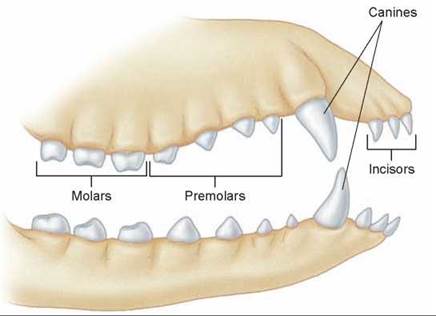Having the teeth differentiated into incisors canines and molars as in man. Having or being teeth that are all of similar form the porpoise is a homodont animal compare heterodont.
Homodont or isodont type teeth is a condition where the teeth are all alike in their shape and size eg.

. Fishes amphibians reptiles and in the extinct toothed birds homodont or isodont condition is observed. Humans and ferrets represent typical mammals with a heterodont dentition composed of incisors one canine premolars and molars and all teeth except molars are replaced once. Homodont or isodont type of teeth is a condition where the teeth are all alike in their shape and size eg the toothed whales Odontoceti.
Pinnipedians show a tendency towards homodont condition. No one is specialized for a particular function examples of animal with such dentition are reptiles fishes and amphibianstherefore the answer is lizard cos lizard is a reptile. These are typical of animals specialized in eating fish insects and crustaceans.
Among mammals only certain cetaceans have homodont dentition ie teeth which are all similar in shape. Homodont dentition is found in the majority of vertebrates such as fish amphibia and reptiles in which all teeth are functionally and anatomically of the same type although their size may be variable depending on the location. Homodont dentition is found in the majority of vertebrates such as fish amphibia and reptiles in which all teeth are functionally and anatomically of the same type although their size may be variable depending on the location.
In anatomy a heterodont from Greek meaning different teeth is an animal which possesses more than a single tooth morphologyIn vertebrates heterodont pertains to animals where teeth are differentiated into different forms. Within the amniotes a homodont dentition is usually associated with reptiles. D Tricuspid teeth of the posterior jaw at the back of the mouth.
Frog lizard and dolphin Heterodont. The toothed whales Odontoceti. Lizards frogs dolphins etcHETERODONT.
For example members of the Synapsida generally possess incisors canines premolars and molars. Homodont Describing animals whose teeth are all of the same type. Fishes amphibians reptiles and in the extinct toothed birds the homodont or isodont condition is observed.
HETERODONT DENTITION is a type of teeth with different sizes shape and. Heterodont mamals have difference teeth ather than all the same teeth. In anatomy a heterodont from Greek meaning different teeth is an animal which possesses more than a single tooth morphologyIn vertebrates heterodont pertains to animals where teeth are differentiated into different forms.
Animals with this dentition specialize in eating hard-shelled mollusks. Opposed to homodont. Examples include the Chinese alligator and the alligator.
Human dog rabbit What are heterodont mammals. Vertebrate Possessing teeth that are differentiated into several forms eg. Sometimes functionally some teeth may be specialized as fangs of snakes.
Scale bar 1 mm AD and 200 μm DD. 52 rows Animals whose teeth are all of the same type such as most non-mammalian vertebrates are said to have homodont dentition whereas those whose teeth differ morphologically are said to have heterodont dentition. Invertebrate Applied to a hinge dentition occurring in the Bivalvia where teeth of differing sizes occur in the hinge plateThe teeth are differentiated into cardinal teeth which occur beneath the umbo and lateral teeth which occur posteriorly and anteriorly to the umbo.
The most complex teeth as observed in animals such as the giant panda are large with multiple cusps for crushing and grinding Evans et al 2007. Most reptiles have a homodont dentition which is continuously replaced. Source for information on homodont.
A Dictionary of Biology dictionary. HOMODONT is a type of teeth which has the same size shape and perform the same function. Further the number of teeth in these homodont mammals varies between 2 and 200.
For example members of the Synapsida. In certain mammals such as toothed whales dolphins porpoises and armadillos teeth become secondarily uniform or homodont. Pinnipedians show a tendency towards homodont condition.
Homodont are the animals which have similar kind of teethFor example. What A consequence of pasture littered with polythene materials To control the spread of diseases on a farm the farmer Which of the following farm animals is a monogastric. D Unicuspid teeth of the anterior jaw at the front of the mouth.
As some examples we have the Indian gharial and the Australian freshwater crocodile. Heterodont are the animals which have different kinds of teethFor. The dentition of animals with two successions of teeth deciduous permanent is referred to as diphyodont while the dentition.
A Homodont unicuspid snake Python molurus B homodont gecko Paroedura picta C homodont tricuspid Monitor lizard Varanus niloticus D heterodont anole Anolis allisoni. Medical Definition of homodont. The dentition of a herbivore is distinct from that of other The diagram above shows the dentition of an organism.
Most vertebrates except mammals are homodont. QuestionWhich of the following animals has homodont dentitionOptionsA RatB ManC LizardD Pigeon.

Heterodont An Overview Sciencedirect Topics

Tooth Shape Changes Within The Jaw Heterodont Homodont Sems Of Adult Download Scientific Diagram

Heterodont Animals Comparative Oral Ent Biology Openstax Cnx

Rebecca Hawkins On Twitter Most Vertebrates Have Homodont Dentition Meaning That Their Teeth All Look The Same But Most Mammals Have Heterodont Dentition Since Their Teeth Have Varying Shapes For Different Purposes

Heterodont Animals Comparative Oral Ent Biology Openstax Cnx

The Mouth And Teeth The Path Of Food Through The Animal Body Animal Life The Living World
0 comments
Post a Comment